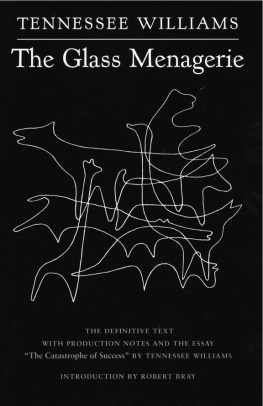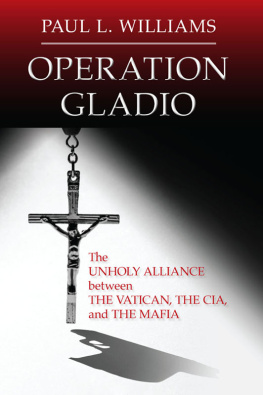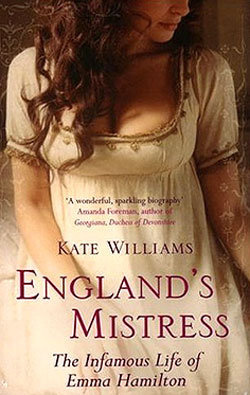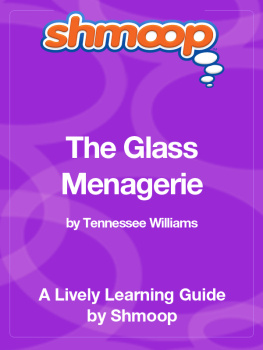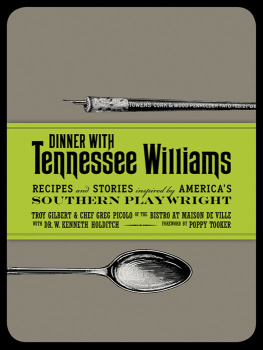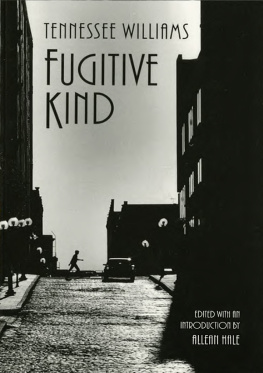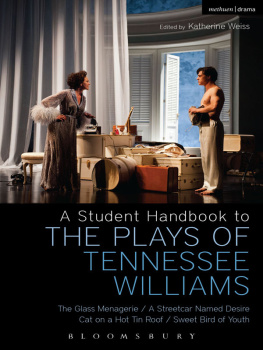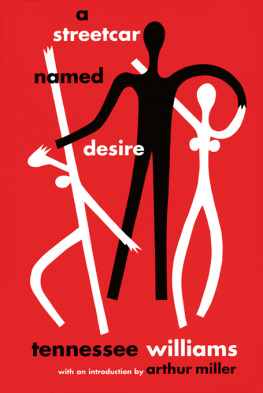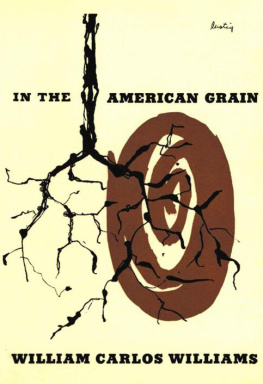TENNESSEE WILLIAMS
The Glass Menagerie
nobody, not even the rain, has such small hands
E. E. Cummings
INTRODUCTION BY ROBERT BRAY
A NEW DIRECTIONS BOOK
CAST LISTING
The Glass Menagerie was first produced by Eddie Dowling and Louis J. Singer at the Civic Theatre, Chicago, Illinois, on December 26, 1944, and at the Playhouse Theatre, New York City, on March 31, 1945. The setting was designed and lighted by Jo Mielziner; original music was composed by Paul Bowles; the play was staged by Eddie Dowling and Margo Jones. The cast was as follows:
| THE MOTHER | Laurette Taylor |
| HER SON | Eddie Dowling |
| HER DAUGHTER | Julie Haydon |
| THE GENTLEMAN CALLER | Anthony Ross |
SCENE
SCENE: An alley in St. Louis
Part I. Preparation for a Gentleman Caller.
Part II. The Gentleman calls.
TIME: Now and the Past
THE CHARACTERS
AMANDA WINGFIELD (the mother)
A little woman of great but confused vitality clinging frantically to another time and place. Her characterization must be carefully created, not copied from type. She is not paranoiac, but her life is paranoia. There is much to admire in Amanda, and as much to love and pity as there is to laugh at. Certainly she has endurance and a kind of heroism, and though her foolishness makes her unwittingly cruel at times, there is tenderness in her slight person.
LAURA WINGFIELD (her daughter)
Amanda, having failed to establish contact with reality, continues to live vitally in her illusions, but Lauras situation is even graver. A childhood illness has left her crippled, one leg slightly shorter than the other, and held in a brace. This defect need not be more than suggested on the stage. Stemming from this, Lauras separation increases till she is like a piece of her own glass collection, too exquisitely fragile to move from the shelf.
TOM WINGFIELD (her son)
And the narrator of the play. A poet with a job in a warehouse. His nature is not remorseless, but to escape from a trap he has to act without pity.
JIM O'CONNOR (the gentleman caller)
A nice, ordinary, young man.
AUTHORS PRODUCTION NOTES
Being a memory play, The Glass Menagerie can be presented with unusual freedom of convention. Because of its considerably delicate or tenuous material, atmospheric touches and subtleties of direction play a particularly important part. Expressionism and all other unconventional techniques in drama have only one valid aim, and that is a closer approach to truth. When a play employs unconventional techniques, it is not, or certainly shouldnt be, trying to escape its responsibility of dealing with reality, or interpreting experience, but is actually or should be attempting to find a closer approach, a more penetrating and vivid expression of things as they are. The straight realistic play with its genuine Frigidaire and authentic ice-cubes, its characters who speak exactly as its audience speaks, corresponds to the academic landscape and has the same virtue of a photographic likeness. Everyone should know nowadays the unimportance of the photographic in art: that truth, life, or reality is an organic thing which the poetic imagination can represent or suggest, in essence, only through transformation, through changing into other forms than those which were merely present in appearance.
These remarks are not meant as a preface only to this particular play. They have to do with a conception of a new, plastic theatre which must take the place of the exhausted theatre of realistic conventions if the theatre is to resume vitality as a part of our culture.
THE SCREEN DEVICE: There is only one important difference between the original and the acting version of the play and that is the omission in the latter of the device that I tentatively included in my original script. This device was the use of a screen on which were projected magic-lantern slides bearing images or titles. I do not regret the omission of this device from the original Broadway production. The extraordinary power of Miss Taylors performance made it suitable to have the utmost simplicity in the physical production. But I think it may be interesting to some readers to see how this device was conceived. So I am putting it into the published manuscript. These images and legends, projected from behind, were cast on a section of wall between the front-room and dining-room areas, which should be indistinguishable from the rest when not in use.
The purpose of this will probably be apparent. It is to give accent to certain values in each scene. Each scene contains a particular point (or several) which is structurally the most important. In an episodic play, such as this, the basic structure or narrative line may be obscured from the audience; the effect may seem fragmentary rather than architectural. This may not be the fault of the play so much as a lack of attention in the audience. The legend or image upon the screen will strengthen the effect of what is merely allusion in the writing and allow the primary point to be made more simply and lightly than if the entire responsibility were on the spoken lines. Aside from this structural value, I think the screen will have a definite emotional appeal, less definable but just as important. An imaginative producer or director may invent many other uses for this device than those indicated in the present script. In fact the possibilities of the device seem much larger to me than the instance of this play can possibly utilize.
THE MUSIC: Another extra-literary accent in this play is provided by the use of music. A single recurring tune, The Glass Menagerie, is used to give emotional emphasis to suitable passages. This tune is like circus music, not when you are on the grounds or in the immediate vicinity of the parade, but when you are at some distance and very likely thinking of something else. It seems under those circumstances to continue almost interminably and it weaves in and out of your preoccupied consciousness; then it is the lightest, most delicate music in the world and perhaps the saddest. It expresses the surface vivacity of life with the underlying strain of immutable and inexpressible sorrow. When you look at a piece of delicately spun glass you think of two things: how beautiful it is and how easily it can be broken. Both of those ideas should be woven into the recurring tune, which dips in and out of the play as if it were carried on a wind that changes. It serves as a thread of connection and allusion between the narrator with his separate point in time and space and the subject of his story. Between each episode it returns as reference to the emotion, nostalgia, which is the first condition of the play. It is primarily Lauras music and therefore comes out most clearly when the play focuses upon her and the lovely fragility of glass which is her image.
THE LIGHTING: The lighting in the play is not realistic. In keeping with the atmosphere of memory, the stage is dim. Shafts of light are focused on selected areas or actors, sometimes in contradistinction to what is the apparent center. For instance, in the quarrel scene between Tom and Amanda, in which Laura has no active part, the clearest pool of light is on her figure. This is also true of the supper scene, when her silent figure on the sofa should remain the visual center. The light upon Laura should be distinct from the others, having a peculiar pristine clarity such as light used in early religious portraits of female saints or madonnas. A certain correspondence to light in religious paintings, such as El Grecos, where the figures are radiant in atmosphere that is relatively dusky, could be effectively used throughout the play. (It will also permit a more effective use of the screen.) A free, imaginative use of light can be of enormous value in giving a mobile, plastic quality to plays of a more or less static nature.
Next page
